Study the Influence of Cable Breakage on Wind-Induced Vibration Characteristics of the Curved Beam Unilateral Stayed Bridge
Abstract
:1. Introduction
2. Broken Cable Simulation and Finite Element Analysis of Cable Breaks
2.1. Aerostatic Force Tests of a CBUSB
2.2. Building of the Finite Element Model of the CBUSB
- (1)
- State 1 corresponds to the time t < t0, when the structure was not broken. In the structural dynamic characteristics analysis after accidental cable breakage, t0 can be determined for research purposes [27,28]. Before cable breakage, the loading time step is 0.125 s, and t0 equals 130 s. The dynamic characteristics during the unbroken cable phase due to random wind loads were analyzed based on a sample size of 1040(=130/0.125). The cable breakage due to accidental factors was selected as occurring at the target cable. The cable force time-varying value F0(t) of the target cable was extracted by numerical analysis with t < t0. During the broken cable modeling analysis, the target cable was removed and F0(t) was used to simulate the dynamic action of the target cable on the bridge to achieve the equivalent bridge forces before cable breakage.
- (2)
- State 2 corresponds to the time t0 ≤ t ≤ t1, when the structure was under the process of cable breakage. During cable breakage, the loading time step is 0.0001, and Δt equals 0.05 s. The structure was in the process of cable fatigue, and both F0(t0) and F1(t) were applied at the connection point of the target cable and the main beam. The direction of F0(t0) is opposite to that of F1(t); the former is the pulling force and the latter is the pushing force. The bridge was under the equivalent tensile force F0(t0) because the cable was not completely broken.
- (3)
- State 3 corresponds to the time t1 < t, when the structure was in the stage of post-breakage. The target cable is no longer applied by F0(t0) and F1(t) at the connection point of the target cable and the main beam., with a time step of 0.125 s. The dynamic characteristics after cable breakage by random wind loads were analyzed based on a sample size of 3000.
3. Parametric Analysis of Cable Fracture
3.1. Analysis of Influence Parameters of Curvature Change
3.2. Analysis of the Cable Arrangement Case
4. Analysis of Broken Cables in Risk Regions of Bridges
4.1. Wind-Induced Vibration Response Assessment of Bridges with Cable Breakage in Different Regions
4.2. Cable Reinforcement Scheme
4.3. DAF Value of Cable Structure Breakage
5. Conclusions
- In wind-induced vibration analysis considering the influence of cable breakages, it is necessary to determine the aerodynamic coefficients of the CBUSB by wind tunnel tests of its sectional model. To analyze the influence of cable breakage on the whole wind-induced vibration process of CBUSBs, the whole time-domain calculation should be divided into three states: before cable breakage, during cable breakage, and after cable breakage.
- With increasing curvature, the main vibration mode of the CBUSB is far away from the wind predominant frequency, and the fluctuation component is changed, which makes the proportion of resonant response smaller. For CBUSBs with unilateral or bilateral cable arrangements, their wind-induced vibration behavior is significantly different. The former has dynamic characteristics and the latter has quasi-static characteristics. The peak wind-induced response of the CBUSB and the internal force redistribution effects due to the cable breakage are smaller when the cables are arranged on the side close to the curvature center than those when cables are arranged on the other side. Meanwhile, the former can be used as the optimal scheme for such structural design.
- The breakage of the shortest cable at 7/33 to 7/22 of the curved beam length and its symmetry part can significantly increase the peak wind-induced response of CBUSBs, which leads the tension spectrum to have a dense distribution of higher-order frequencies. As the proportion of resonance response in fluctuating response increases, there is a possibility of cable breakage again. The DAF recommended values by existing codes do not consider the combined influence of wind and cable breakages, whereas the values provided in this paper accurately consider the amplification effect of wind-induced vibration caused by cable breakage.
Author Contributions
Funding
Data Availability Statement
Conflicts of Interest
References
- Zhao, S.; Chen, J.H.; Yue, J.H.; Yan, Z.T.; Liu, J.; Zhang, B.; Chen, J.F. Sectional model wind tunnel test and research on the wind-induced vibration response of a curved beam unilateral stayed bridge. Buildings 2022, 12, 1643. [Google Scholar] [CrossRef]
- Briseghella, B.; Fa, G.; Aloisio, A.; Pasca, D.; He, L.; Fenu, L.; Gentile, C. Dynamic characteristics of a curved steel–concrete composite cable-stayed bridge and effects of different design choices. Structures 2021, 34, 4669–4681. [Google Scholar] [CrossRef]
- Zhao, G.; Wang, Z.; Zhu, S.; Hao, J.; Wang, J. Experimental study of mitigation of wind-induced vibration in asymmetric cable-stayed bridge using sharp wind fairings. Appl. Sci. 2022, 12, 242. [Google Scholar] [CrossRef]
- Wu, Y.; Wu, X.; Li, J.; Xin, H.; Sun, Q.; Wang, J. Investigation of vortex-induced vibration of a cable-stayed bridge without backstays based on wind tunnel tests. Eng. Struct. 2022, 250, 113436. [Google Scholar] [CrossRef]
- Cai, J.G.; Wang, F.L.; Feng, J. Conceptual design of large span spatial structure against continuous collapse. J. Archit. Eng. 2010, S1, 283–287. [Google Scholar]
- Yu, G.; Sun, L.M. Analysis of structural vulnerability of cable-stayed Bridges caused by broken cables. J. Tongji Univ. 2010, 38, 323–328. [Google Scholar]
- Guo, J.; Guan, Z. Optimization of the cable forces of completed cable-stayed bridges with differential evolution method. J. Struct. 2023, 47, 1416–1427. [Google Scholar] [CrossRef]
- Abdel, F.M.T.; Abdel, F.T.T. Influence of pylon configuration on the response of cable-stayed bridges to sudden cable loss. Proc. Inst. Civ. En-Bridge. Eng. 2023, 176, 58–66. [Google Scholar]
- Xiang, Y.; Chen, Z.; Yang, Y.; Lin, H.; Zhu, S. Dynamic response analysis for submerged floating tunnel with anchor-cables subjected to sudden cable breakage. Mar. Struct. 2018, 59, 179–191. [Google Scholar] [CrossRef]
- DC45.1-2012; Recommendations for Stay Cable Design, Testing and Installation. P.T.I Farmington Hills: Farmington Hills, MI, USA, 2012; pp. 34–35.
- Mozos, C.M.; Aparicio, A.C. Numerical and experimental study on the interaction cable structure during the failure of a stay in a cable stayed bridge. J. Eng. Struct. 2011, 33, 2330–2341. [Google Scholar] [CrossRef]
- Cai, J.G.; Xu, Y.X.; Zhuang, L.P. Comparison of various procedures for progressive collapse analysis of cable-stayed bridges. J. Zhejing Univ. 2012, 13, 323–334. [Google Scholar] [CrossRef]
- Li, S.H.; Ren, J.Y. Analytical study on dynamic responses of a curved beam subjected to three-directional moving loads. Appl. Math. Model. 2018, 58, 365–387. [Google Scholar] [CrossRef]
- Qian, C.; Zhu, L.; Zhu, Q.; Ding, Q.; Yan, L. Pattern and mechanism of wind-induced static instability of super-long-span cable-stayed bridge under large deformation. J. Wind. And. Ind. Aero. 2022, 221, 104910. [Google Scholar] [CrossRef]
- Atmaca, B.; Ghafoori, R.; Dede, T.; Ateş, Ş. The effect of post-tensioning force and different cable arrangements on the behavior of cable-stayed bridge. Structures 2022, 44, 1824–1843. [Google Scholar] [CrossRef]
- Xie, T.; Mohamed, A.M.S.; Elchalakani, M.; David, M. Experimental and analytical study of ultrahigh-performance fiber-reinforced concrete curved beams. J. Struct. Eng. 2020, 146, 91–92. [Google Scholar] [CrossRef]
- Wang, T.; Zhang, X.B.; Wang, L. The Investigation on dynamic response of cable-stayed bridge and train on bridge under cable break conditions. J. Southwest Jiaotong Univ. 2022, 258, 51–1277. [Google Scholar]
- Yang, X. Research on calculation method and Influencing factors of asymmetric cable-stayed Bridge. J. Lanzhou Jiaotong Univ. 2021, 1, 153–241. [Google Scholar]
- Yukari, A.; Hamid, V.; Bijan, S. A study on potential progressive collapse responses of cable-stayed bridges. J. Adv. Struct. Eng. 2013, 16, 689–706. [Google Scholar]
- JGJ/T 338-2014; Ministry of Housing and Urban-Rural Development of the People’s Republic of China. Standard for Wind Tunnel Test of Buildings and Structures; China Architecture and Building Press: Beijing, China, 2014.
- Shao, G.T.; Jin, H.; Jiang, R.N.; Xu, Y. Dynamic response and robustness evaluation of cable-supported arch bridges subjected to cable breaking. J. Shock. Vib. 2021, 2021, 6689630. [Google Scholar] [CrossRef]
- Zhang, Y.; Fang, Z.; Jiang, R.; Xiang, Y.; Long, H.; Lu, J. Static performance of a long-span concrete cable-stayed bridge subjected to multiple-cable loss during construction. J. Bridge. Eng. 2020, 25, 04020002. [Google Scholar] [CrossRef]
- Ali, K.; Katsuchi, H.; Yamada, H. Comparative study on structural redundancy of cable-stayed and extradosed bridges through safety assessment of their stay cables. J. Eng. 2021, 7, 111–123. [Google Scholar] [CrossRef]
- Gimsing, N.J.; Georgakis, C.T. Cable Supported Bridges: Concept and Design; John and Wiley and Sons: Hoboken, NJ, USA, 2011; pp. 1–145. [Google Scholar]
- Zhou, Y.; Chen, S. Reliability assessment framework of the long-span cable-stayed bridge and traffic system subjected to cable breakage events. J. Bridge. Eng. 2017, 22, 04016133. [Google Scholar] [CrossRef]
- Wen, Y.; Zhou, Z. Qualification of the ernst formula for modeling the sag effect of super-long stay cables in the long-span railway cable-stayed bridges. Structures. 2022, 45, 99–109. [Google Scholar] [CrossRef]
- Zheng, X.B.; Zhang, G.; Song, Y.F. Dynamic response of cable failure of steel truss cable-stayed bridge. J. Changan Univ. 2017, 37, 70–77. [Google Scholar]
- Yang, J. Structural Redundancy and System Reliability of Highway Bridges; University of Maryland: College Park, MD, USA, 2015. [Google Scholar]
- Yang, Y.B.; Wu, C.M.; Yau, J.D. Dynamic response of a horizontally curved beam subjected to vertical and horizontal moving loads. J. Sound. Vib. 2001, 242, 519–537. [Google Scholar] [CrossRef]
- Lawrence, J.C.; Terry, J.F. The Band Pass Filter. Int. Econ. Rev. 2003, 44, 435–465. [Google Scholar]
- EN1991-2; Eurocode 1: Action on Structures—Part 2: Traffic Loads on Bridges. British Standard Institution: London, UK, 2006; pp. 134–137.
- DT2832-2001; Haubans. Recommandations de la Commission Interministérielle de la Précontrainte. Service d’Etudes Techniques des Routes et Autoroutes: Bagneu, France, 2001; pp. 179–181.
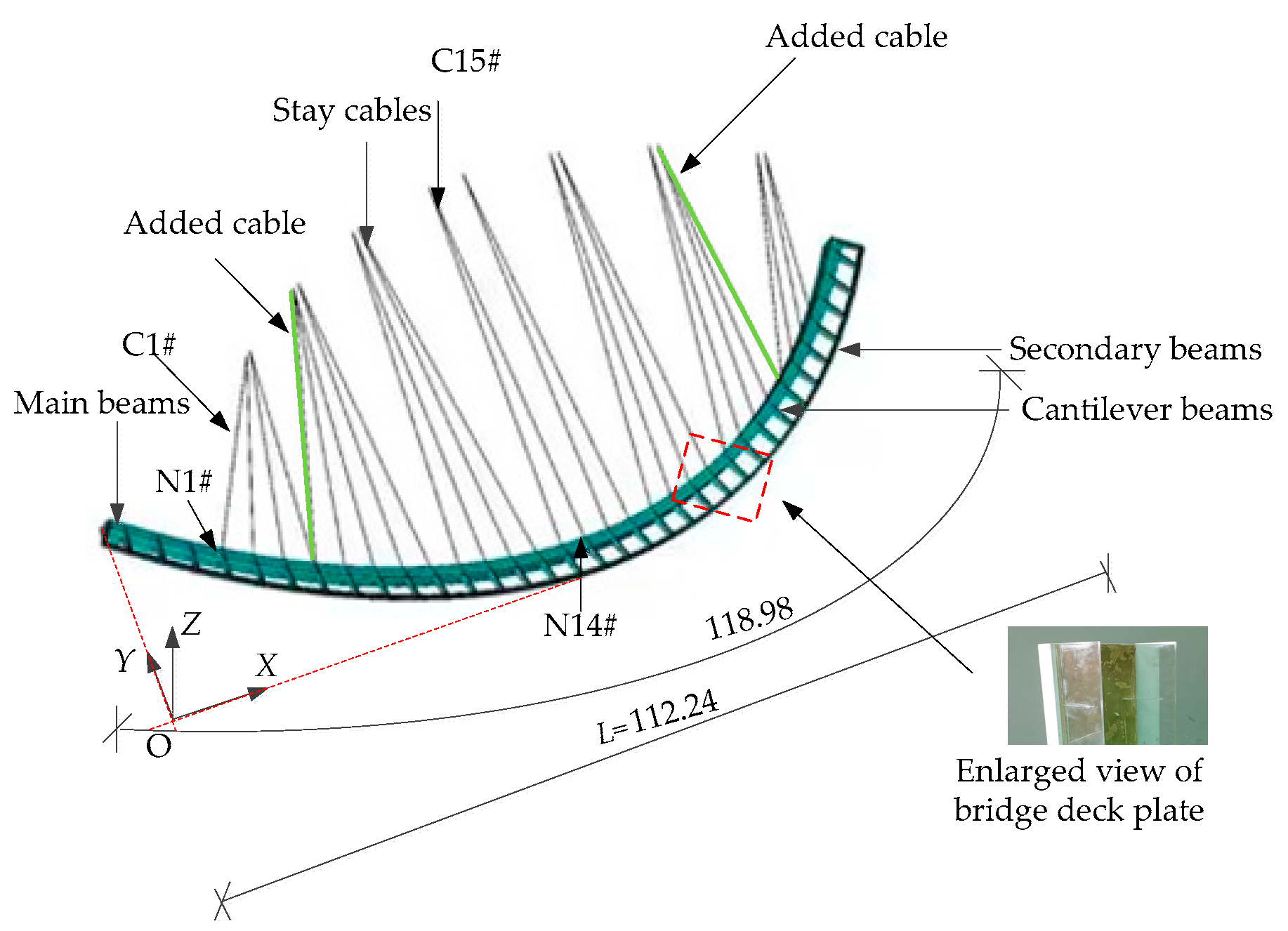
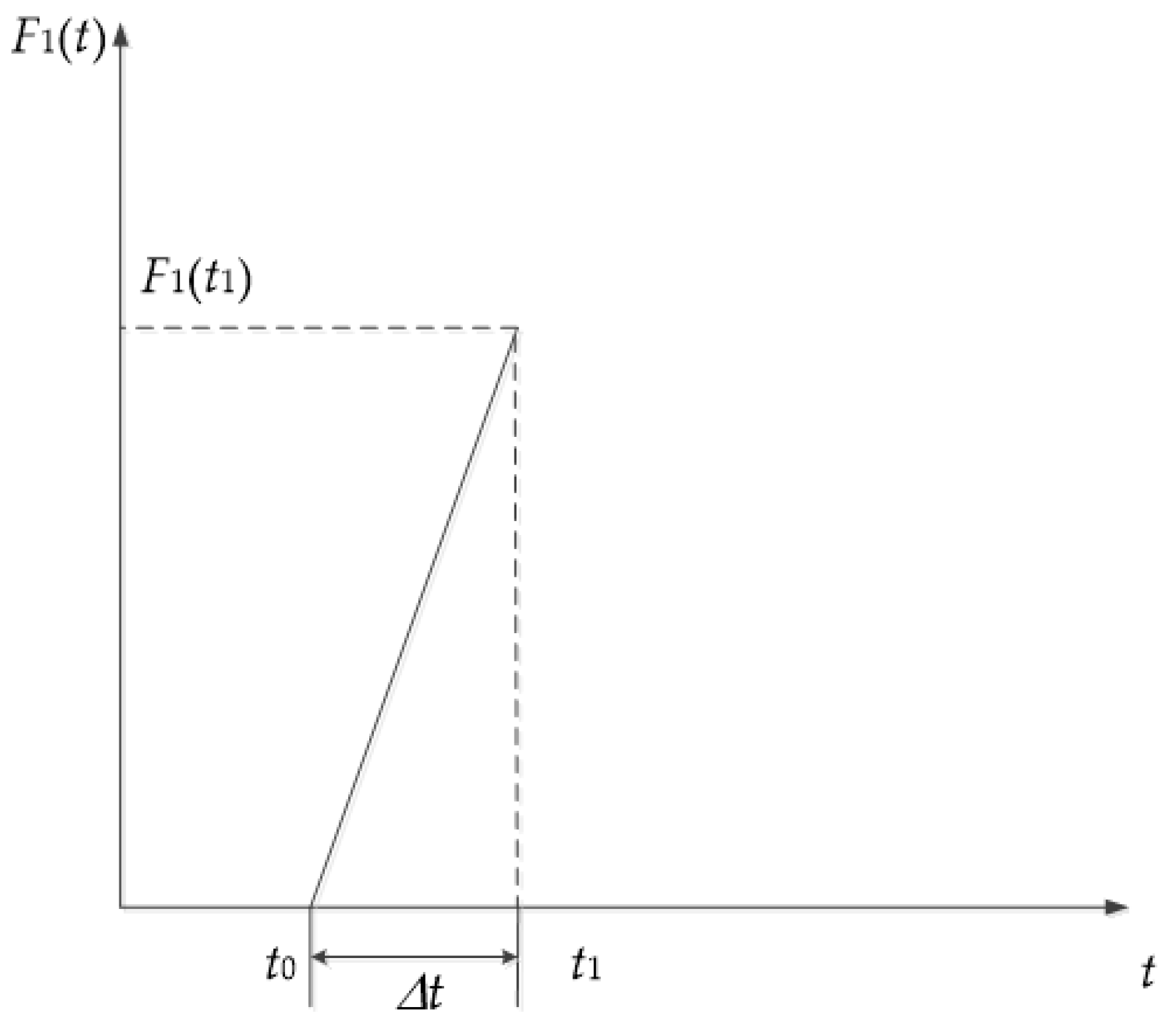
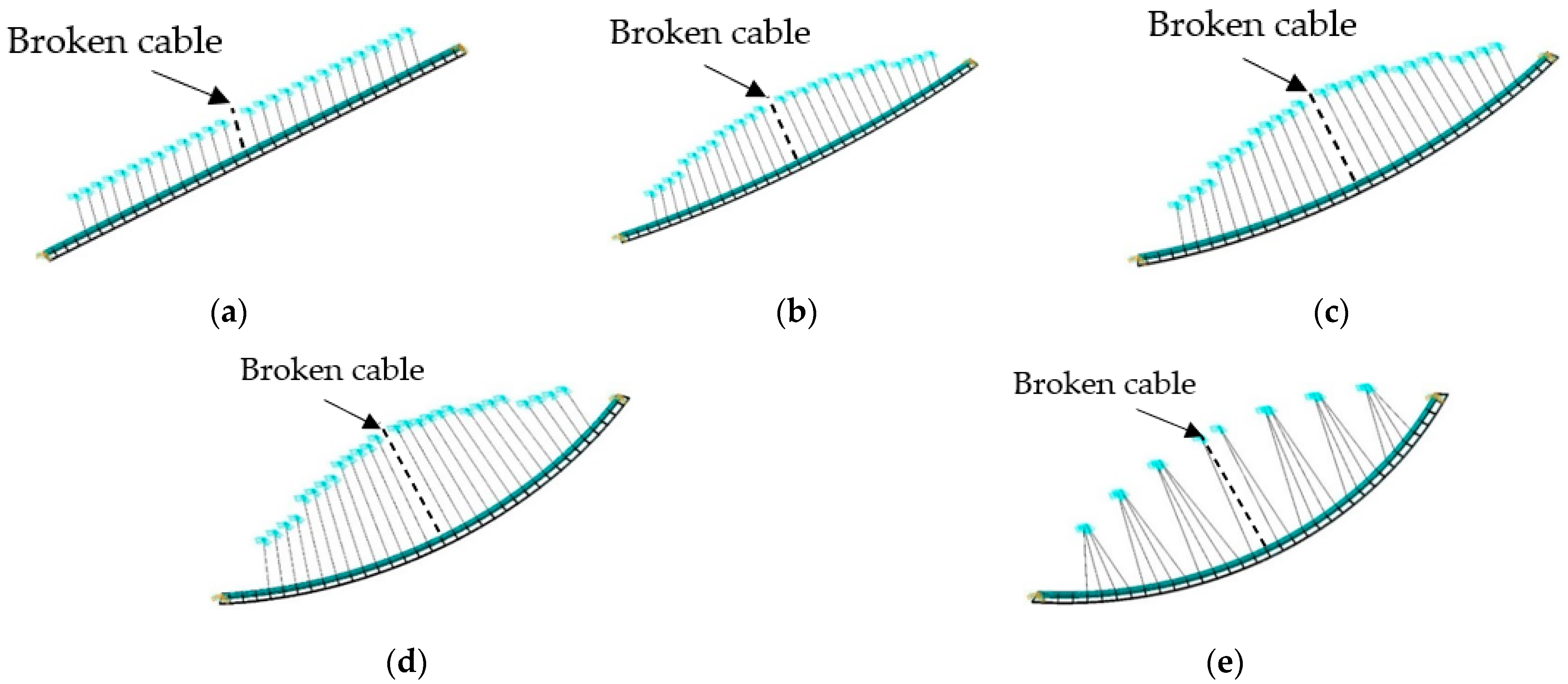
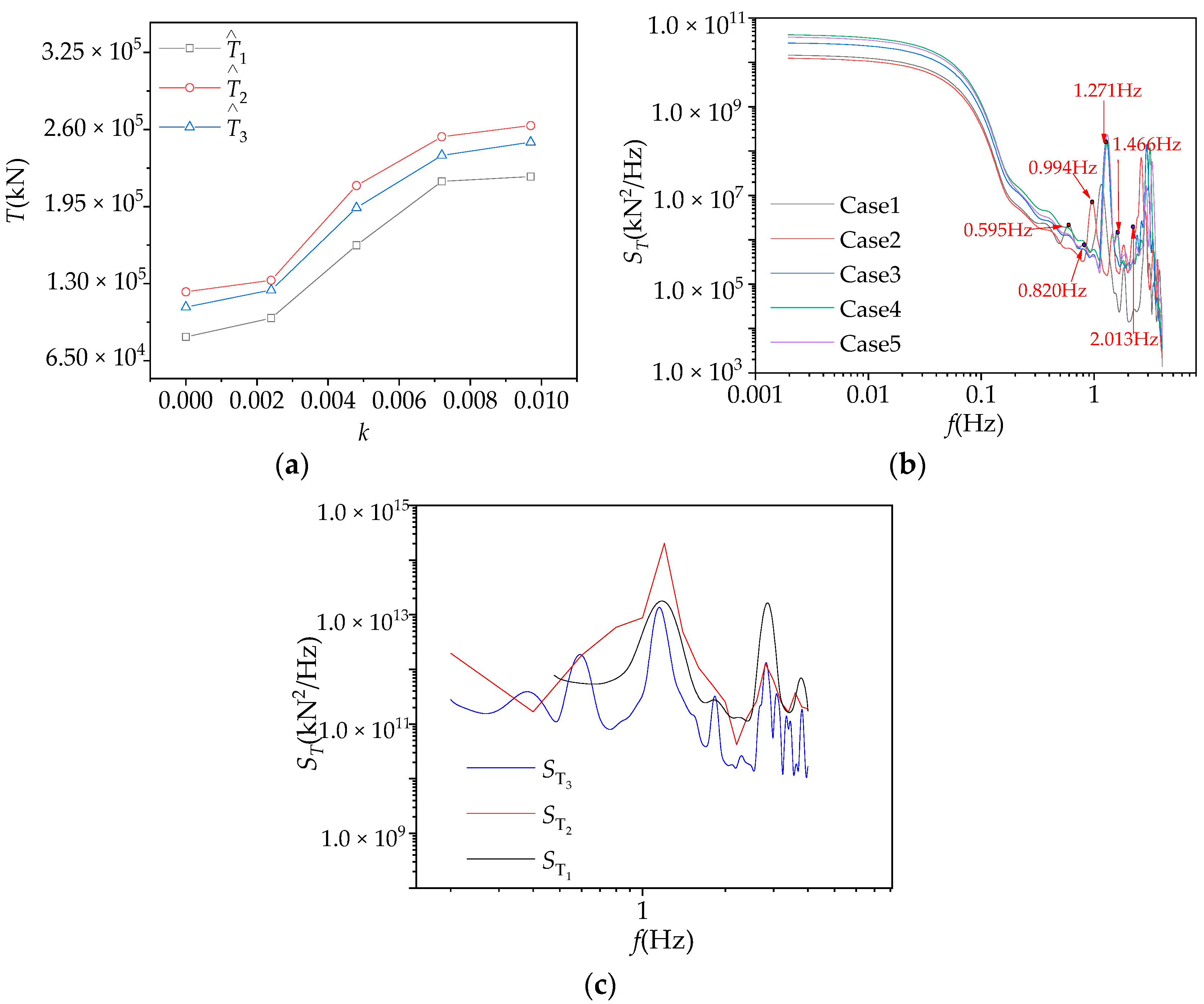
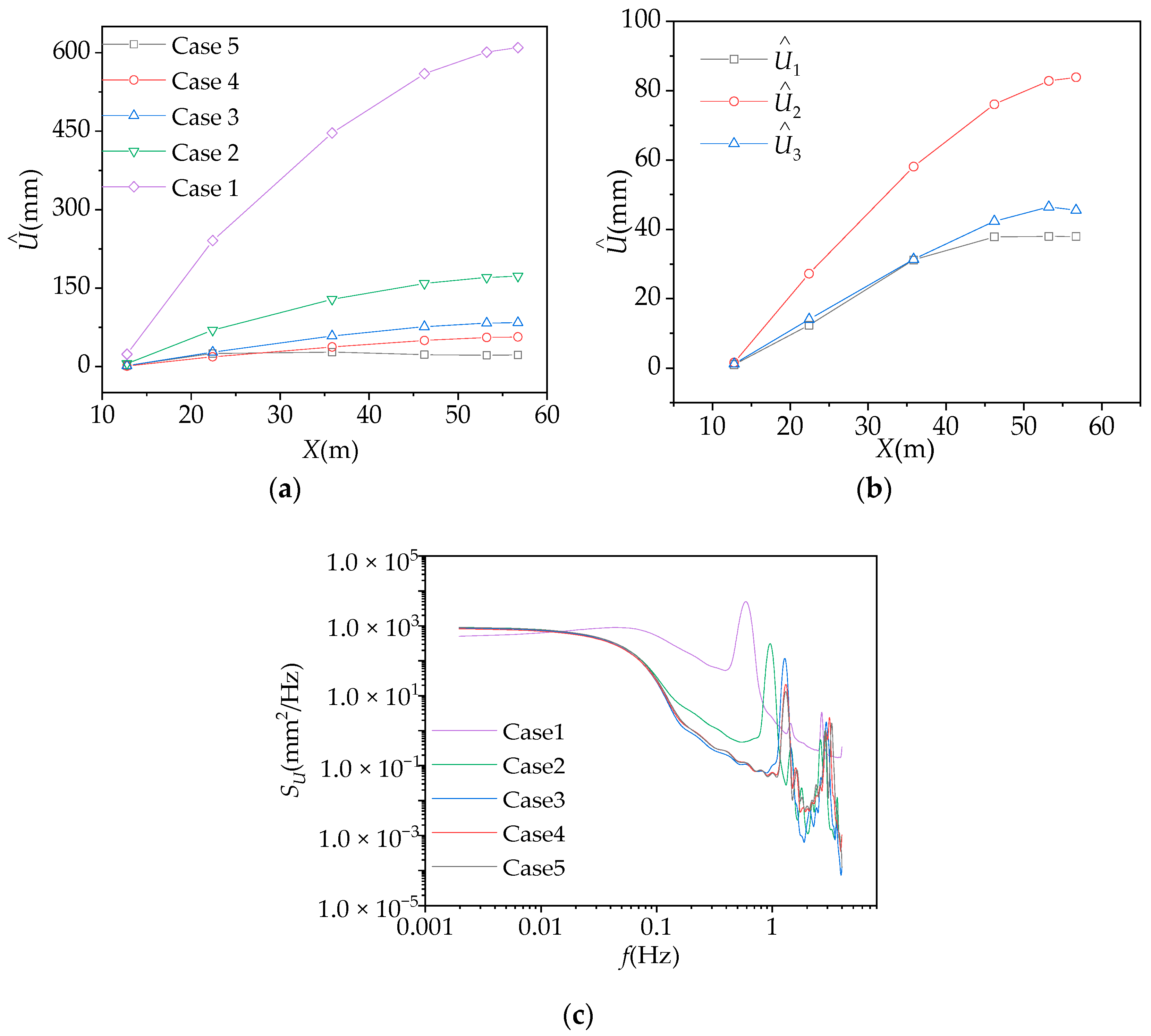
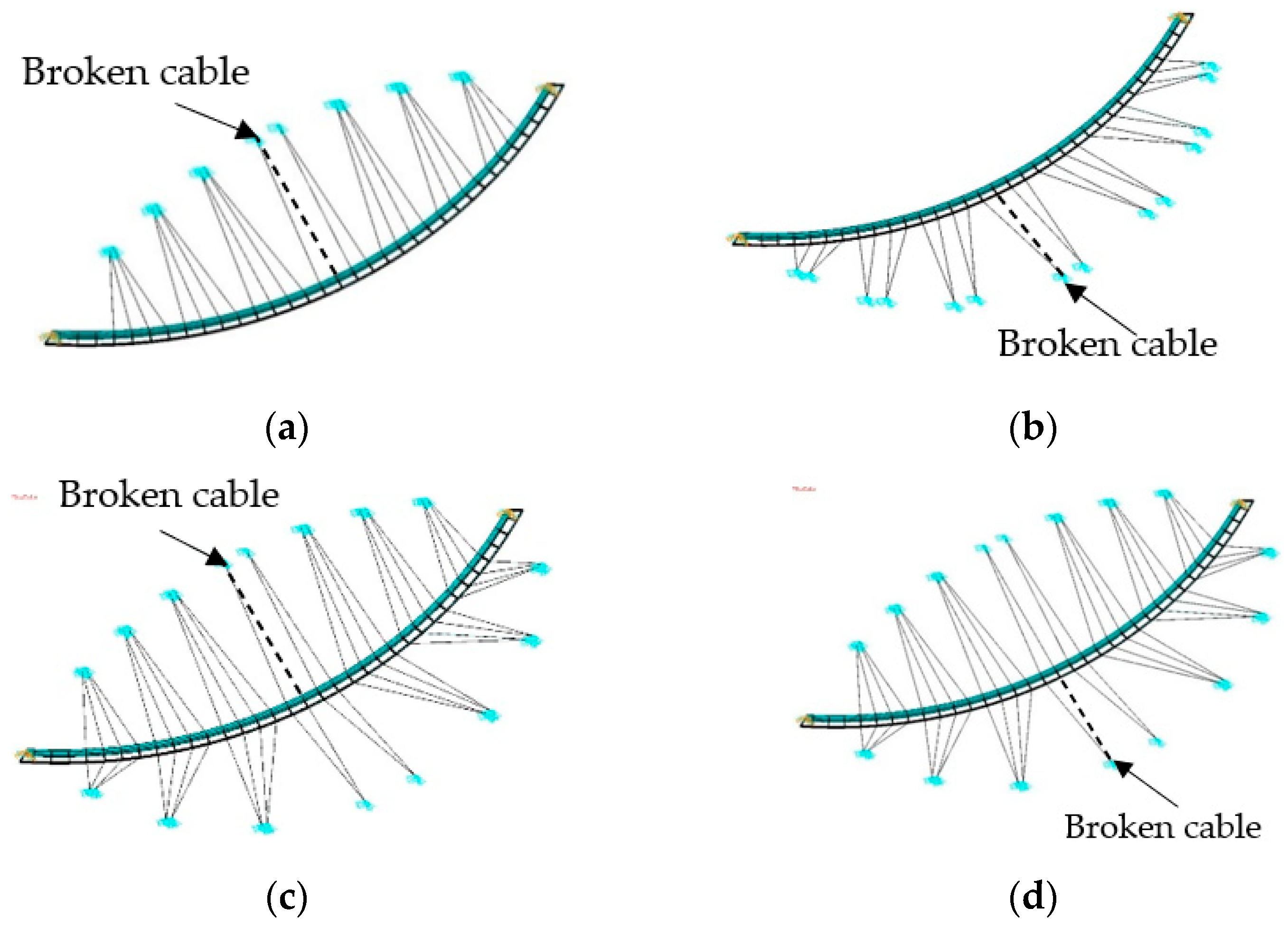
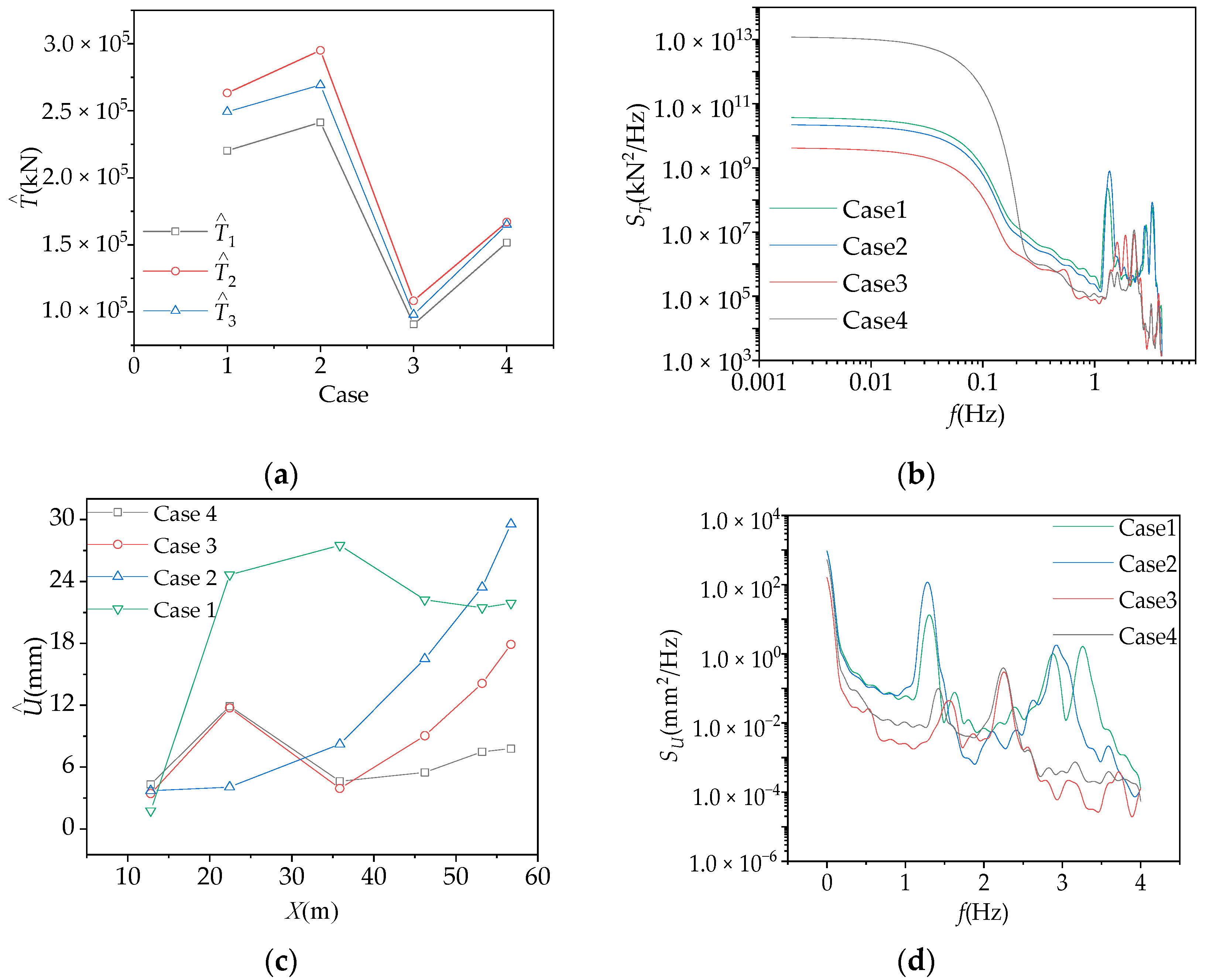

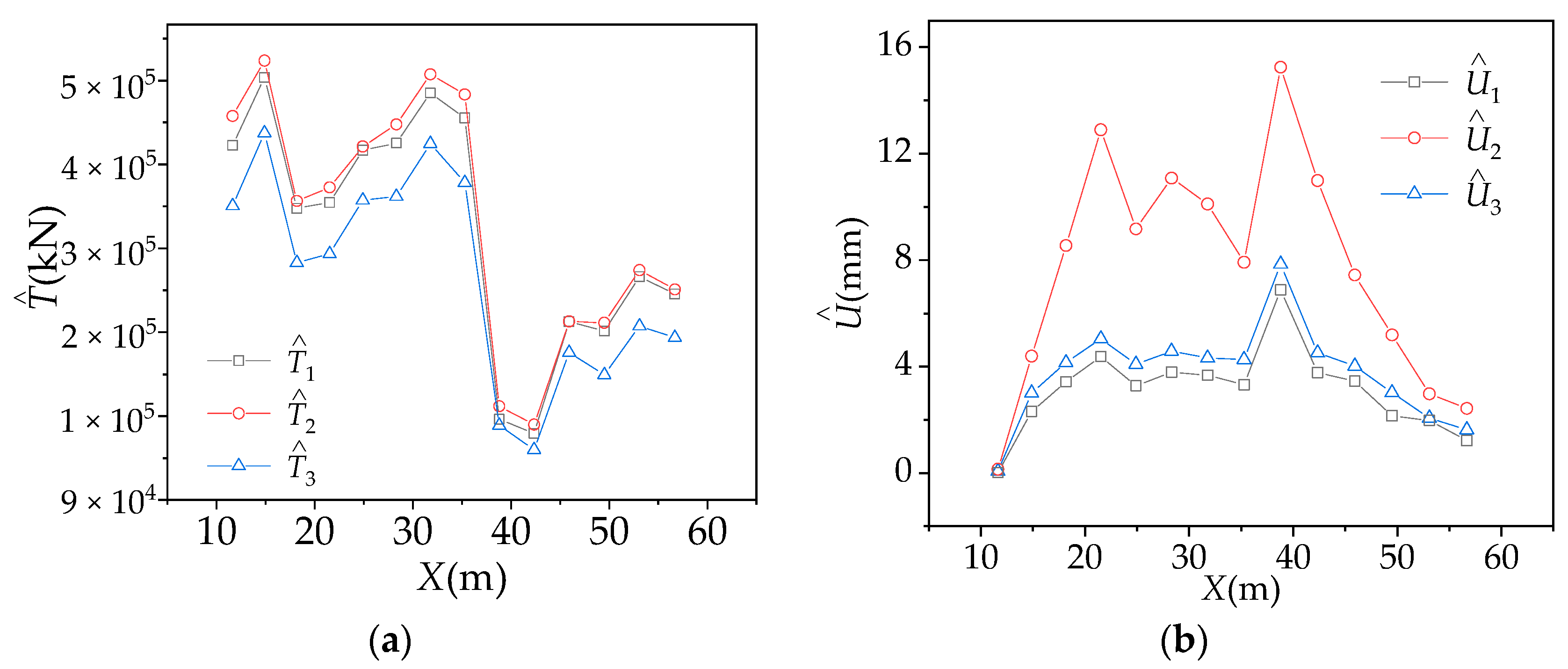
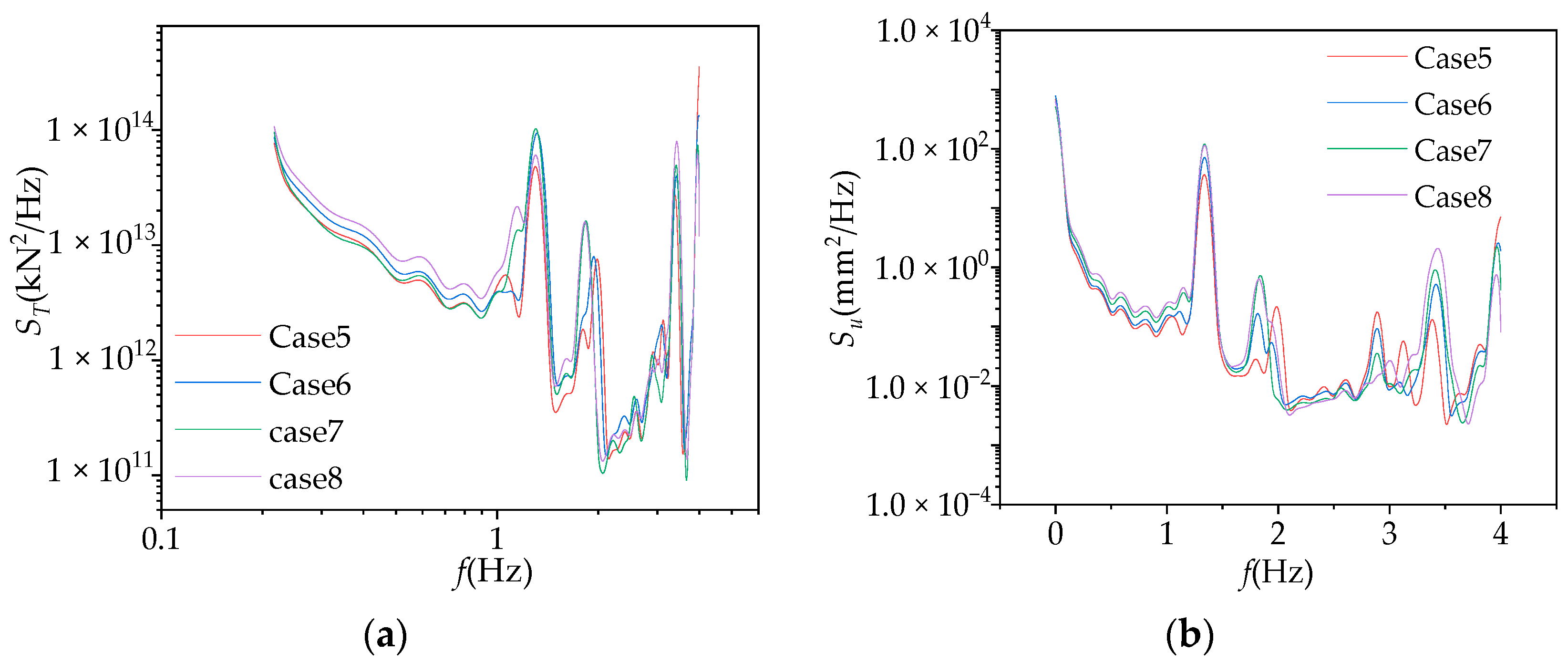
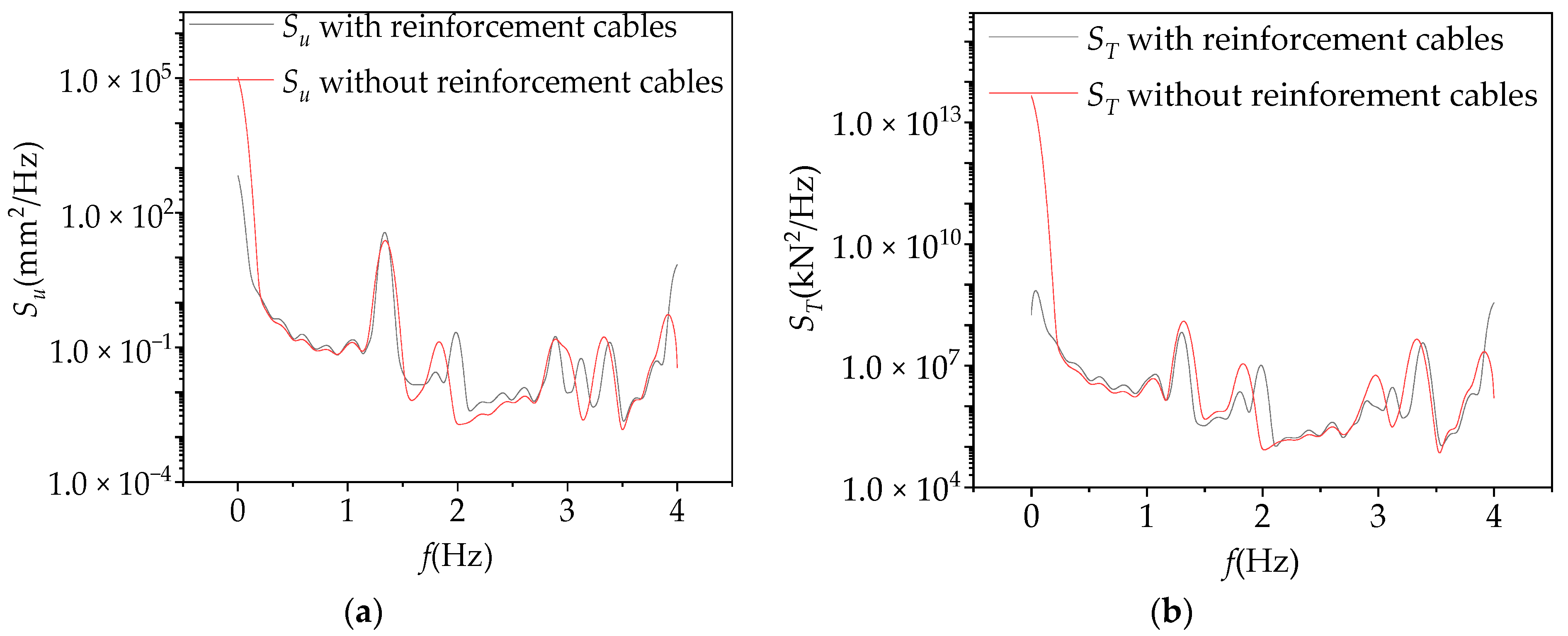
| Cable Case Number | Cable Region Division | Cable Number |
|---|---|---|
| Case 1 | Section 1 | C1# |
| Case 2 | C2# | |
| Case 3 | C3# | |
| Case 4 | C4# | |
| Case 5 | Section 2 | C6# |
| Case 6 | C7# | |
| Case 7 | C8# | |
| Case 8 | C9# | |
| Case 9 | Section 3 | C10# |
| Case 10 | C11# | |
| Case 11 | C12# | |
| Case 12 | C13# | |
| Case 13 | Section 4 | C14# |
| Case 14 | C15# |
| States of Cable Breakage | with Reinforcement Cables (kN) | without Reinforcement Cables (kN) | Change Ratio (%) |
|---|---|---|---|
| State 1 | 2.25 × 105 | 2.67 × 105 | −16 |
| State 2 | 2.69 × 105 | 3.07 × 105 | −13 |
| State 3 | 3.08 × 105 | 3.50 × 105 | −12 |
| States of Cable Breakage | with Reinforcement Cables (kN) | without Reinforcement Cables (kN) | Change Ratio (%) |
|---|---|---|---|
| State 1 | 2.25 × 105 | 2.56 × 105 | −12 |
| State 2 | 2.69 × 105 | 3.08 × 105 | −13 |
| State 3 | 3.08 × 105 | 3.50 × 105 | −12 |
| States of Cable Breakage | with Reinforcement Cables (kN) | without Reinforcement Cables (kN) | Change Ratio (%) |
|---|---|---|---|
| State 1 | 7 | 12 | −42 |
| State 2 | 15 | 20 | −24 |
| State 3 | 24 | 28 | −14 |
| States of Cable Breakage | with Reinforcement Cables (kN) | without Reinforcement Cables (kN) | Change Ratio (%) |
|---|---|---|---|
| State 1 | 7 | 13 | −46 |
| State 2 | 15 | 20 | −24 |
| State 3 | 24 | 28 | −14 |
| Determination Method of DAF Value | Tension DAF | Along-Wind Displacement DAF |
|---|---|---|
| Numerical simulation for CBUSBs without adding cables | 1.4 | 1.6 |
| Numerical simulation for CBUSBs with adding cables | 1.2 | 1.5 |
| Calculated through U.S. code (DC45.1-2012) | 2.0 | |
| Calculated through EU code (EN1991-2) | 1.5 | |
| Calculated through French code (DT2832-2001) | 1.5~2.0 | |
Disclaimer/Publisher’s Note: The statements, opinions and data contained in all publications are solely those of the individual author(s) and contributor(s) and not of MDPI and/or the editor(s). MDPI and/or the editor(s) disclaim responsibility for any injury to people or property resulting from any ideas, methods, instructions or products referred to in the content. |
© 2023 by the authors. Licensee MDPI, Basel, Switzerland. This article is an open access article distributed under the terms and conditions of the Creative Commons Attribution (CC BY) license (https://creativecommons.org/licenses/by/4.0/).
Share and Cite
Zhao, S.; Shi, Y.; Chen, J.; Yan, Z.; Zhang, B.; Zhang, X.; Wang, Z. Study the Influence of Cable Breakage on Wind-Induced Vibration Characteristics of the Curved Beam Unilateral Stayed Bridge. Buildings 2023, 13, 1038. https://doi.org/10.3390/buildings13041038
Zhao S, Shi Y, Chen J, Yan Z, Zhang B, Zhang X, Wang Z. Study the Influence of Cable Breakage on Wind-Induced Vibration Characteristics of the Curved Beam Unilateral Stayed Bridge. Buildings. 2023; 13(4):1038. https://doi.org/10.3390/buildings13041038
Chicago/Turabian StyleZhao, Shuang, Yi Shi, Jiahao Chen, Zhitao Yan, Bin Zhang, Xueqin Zhang, and Zhenqiang Wang. 2023. "Study the Influence of Cable Breakage on Wind-Induced Vibration Characteristics of the Curved Beam Unilateral Stayed Bridge" Buildings 13, no. 4: 1038. https://doi.org/10.3390/buildings13041038
APA StyleZhao, S., Shi, Y., Chen, J., Yan, Z., Zhang, B., Zhang, X., & Wang, Z. (2023). Study the Influence of Cable Breakage on Wind-Induced Vibration Characteristics of the Curved Beam Unilateral Stayed Bridge. Buildings, 13(4), 1038. https://doi.org/10.3390/buildings13041038








